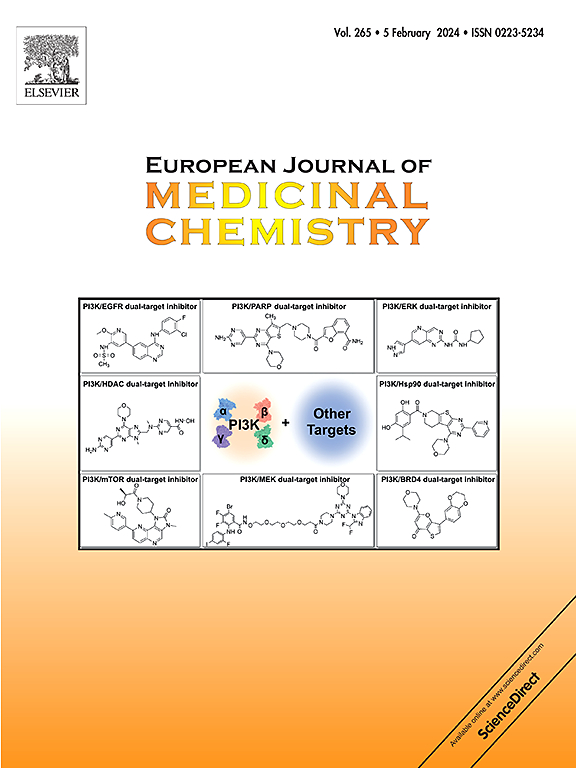溃疡性结肠炎治疗中的小分子、靶点和途径综述
IF 6
2区 医学
Q1 CHEMISTRY, MEDICINAL
引用次数: 0
摘要
溃疡性结肠炎(UC)是一种慢性炎症性肠病,由于其复杂的病理生理、长期性和现有治疗方法的有效性有限,给临床带来了重大挑战。小分子化合物,特别是那些能够调节炎症相关信号通路的化合物,在许多情况下,存在于自然界,为传统疗法提供了一种有希望的替代或补充。从Web of Science (WOS)数据库中收集了过去30年来1394篇关于UC治疗药物的分子研究报告。仅纳入通过动物实验验证治疗效果的研究。通过网络药理学的分子分类和结构分析以及常见的靶点和通路,我们确定了14类化合物,5个直接靶点模块和3个关键的下游通路。生物碱、苯丙素、黄酮类和萜烯(及其衍生物)出现频率最高,主要针对脂质代谢、氧化应激、免疫调节、信号转导和癌症相关途径。值得注意的是,在过去的五年中,在临床前和临床试验中应用天然来源的化合物,特别是类黄酮的趋势越来越明显。尽管UC研究取得了进展,但大多数研究都集中在整体治疗效果和生物标志物改变上,对直接靶点和潜在机制的关注有限。这些发现强调了探索新的UC小分子治疗策略的必要性,重点是明确定义的靶点和精确的作用模式。本文章由计算机程序翻译,如有差异,请以英文原文为准。


A comprehensive review of small molecules, targets, and pathways in ulcerative colitis treatment
Ulcerative colitis (UC), a chronic inflammatory bowel disease (IBD), poses significant clinical challenges because of its complex pathophysiology, long-term nature, and the limited efficacy of existing treatments. Small-molecule compounds, particularly those that are able to modulate inflammation-related signaling pathways and, in many cases, occur in nature, offer a promising alternative or supplement to conventional therapies. Studies on molecules for UC therapeutics reported in 1394 publications over the past 30 years were collected from the Web of Science (WOS) database. Only studies that verified therapeutic efficacy through animal experiments were included. Through an analysis of the molecular classes, structures, common targets, and pathways using network pharmacology, we identified 14 classes of compounds, 5 direct-target modules, and 3 crucial downstream pathways. Alkaloids, phenylpropanoids, flavonoids, and terpenes (and their derivatives) appeared most frequently and mainly targeted lipid metabolism, oxidative stress, immune regulation, signaling transduction, and cancer-related pathways. Notably, there has been an increasing trend of applying naturally sourced compounds in both preclinical and clinical trials, especially flavonoids, over the last five years. Although progress in UC research has been made, the majority of studies have focused on the overall therapeutic effects and biomarker alterations, with limited emphasis on the direct targets and underlying mechanisms. These findings highlight the need to explore novel small-molecule therapeutic strategies for UC, focusing on clearly defined targets and precise modes of action.
求助全文
通过发布文献求助,成功后即可免费获取论文全文。
去求助
来源期刊
CiteScore
11.70
自引率
9.00%
发文量
863
审稿时长
29 days
期刊介绍:
The European Journal of Medicinal Chemistry is a global journal that publishes studies on all aspects of medicinal chemistry. It provides a medium for publication of original papers and also welcomes critical review papers.
A typical paper would report on the organic synthesis, characterization and pharmacological evaluation of compounds. Other topics of interest are drug design, QSAR, molecular modeling, drug-receptor interactions, molecular aspects of drug metabolism, prodrug synthesis and drug targeting. The journal expects manuscripts to present the rational for a study, provide insight into the design of compounds or understanding of mechanism, or clarify the targets.

 求助内容:
求助内容: 应助结果提醒方式:
应助结果提醒方式:


